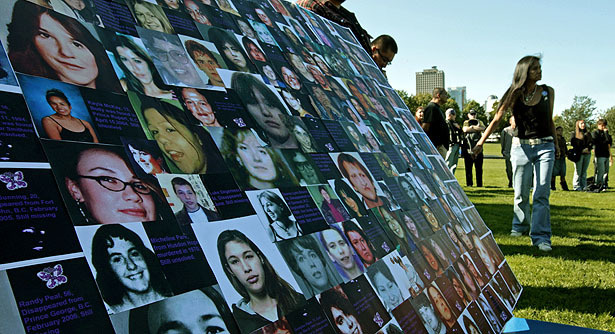
Mama Margarita, a Kamentsa medicine woman, holds the leaves of a frailejón plant that she uses to treat fever and migraines. Photo credit: Monika Wnuk
The smell of gasoline floats through open windows as we wind our way through the foothills of the Sibundoy Valley in southwest Colombia. The sound of children chattering in the back seat and the engine straining against the incline interrupt the early-morning quiet, while blue-hued, predawn light falls on giant ferns scraping against the 21-seater bus.
Up front sits a Kamentsa tribal elder called Mama Margarita. Standing no more than five feet tall, she is a tiny powerhouse of traditional knowledge. After 80 years studying the medicinal plants of the páramo -- an endangered alpine tundra ecosystem -- Mama Margarita says today may be her last time making the eight-hour, round-trip hike into the Andes.
"Nowadays, I cannot come all the way up the mountain alone," she says. "I used to come with two dogs to gather the remedies. At three in the afternoon I would leave the páramo, and arrive back at my house at dark."
Her dogs have since passed away and, as Mama Margarita ages, she makes the trip less and less often.
In Sibundoy, the ancestral territory of the Kamentsa and Inga indigenous people, both the elders and lands that sustain traditional knowledge are disappearing. To keep pace with climate change, globalization and the region's mining development, local groups are banding together to record this information before it disappears.
Among them is an organization called the Asociación de Mujeres Indígenas de la Medicina Tradicional (the Association for Indigenous Women of Traditional Medicine, or "ASOMI" for short) that spearheads ambitious efforts to preserve women's traditional knowledge across Colombia. This information, they believe, is critical to preserving both the identity and the health of local communities.
"ASOMI's role is special because it is vital to carrying on the legacy left by the grandmothers," says María del Rosario "Charito" Chicunque, president of ASOMI. "Much of the knowledge has been lost, but it's not too late to preserve what remains."
Mama Margarita joined ASOMI in 2003. Known in the region as a knowledgeable elder, she received an invitation to the organization's inaugural meeting. Today, several ASOMI representatives accompany Mama Margarita on the trek: Charito; Yolanda Mutumbajoy, ASOMI's treasurer; and anthropologist Denise Ganitsky of the Amazon Conservation Team -- an organization that works closely with ASOMI on a variety of cultural conservation initiatives. They arrived yesterday from their headquarters in Mocoa, a town located three hours away via a dangerous, winding mountain road known for its landslides. The trip was worth the unique chance to document a rare system of healing, Ganitsky says.
"In ASOMI, the women are experts on plants and traditional medicine, but there's one in particular who really knows páramo plants and that's Mama Margarita," she says.
"When these women come together to exchange plants, they're all learning more about traditional medicine. They strengthen their own knowledge and what they can pass on."
It's not just the local people who acknowledge this region's many fascinating species, adds Mark Plotkin, the president of the Amazon Conservation Team who has spent the last 30 years studying connections between humans and plants in Amazonia.
"The Sibundoy Valley represents a sort of mecca for ethnobotanists who study the extraordinary healing properties of medicinal plants and their use by local shamans," he said in a phone call from ACT headquarters in Arlington, Virginia.
To assist on the trip, Mama Margarita also invited two other companions: Rosa Clara Mutumbajoy, her daughter and apprentice, and José Narciso Jamioy Muchavisoy, the former governor of the Kamentsa Community Council. In addition, there are the seven Kamentsa teenagers from the Institución Educativa Bilingüe Artesanal Kamentsa -- a school that teaches both national and traditional curriculum. With its mission to preserve and pass on traditional knowledge, ASOMI organized and sponsored the trip for these young people who now slip on rainjackets and mudboots in preparation for the hike.
The páramo we will all visit today is one of three around Sibundoy and just one portion of roughly 3.7 million acres found throughout Colombia.
Of that total area, 25,000 acres are destroyed every year, a rate that suggests 50 percent of páramos could disappear by the end of the century, according to Dr. Wouter Buytaert and Francisco Cuesta, who recently published a study about páramos in Global Ecology and Biogeography. With this loss, many of the valuable ecosystem services that humans depend on would also disappear.
"You can give the páramo a value in terms of what you would lose in water, carbon pools, and medicinal plants," Cuesta says.
In Sibundoy, the primary threats to this ecosystem are development projects and climate change. Climate change models predict shifts in the páramo's rainfall, temperature, and nutrient availability that could endanger plants, Buytaert explains.
"Given the uniqueness of many species, and the likeliness that a significant number may disappear, it is very important to catalog medicinal plants," he said. "From a scientific perspective, there are probably few plants for which no classic medical alternative exists, but there is of course an entire cultural context which may disappear."
Furthermore, with 28 mining solicitations and 11 contracts already approved, the landscape of the valley is about to change. Today, 80 percent of foreign investment in Colombia goes to the mining and hydrocarbons sector, and that number keeps growing.
Many years ago, Mama Margarita would have hiked from the bottom of the mountain. Today, however, the bus provides a shortcut. As we pile out, Charito and Yolanda give each person a black plastic bag filled with boiled chicken, rice, potatoes and peanuts--the rations for the trip. The children grab the meal and run, leading the pack into the mountains, while Mama Margarita takes her time with the adults in the back. Every so often, she stops to point out a plant. When she does, Charito and Yolanda take photos and write notes about the plant's characteristics and how to prepare it as medicine. When they return to ASOMI, they will transcribe this information to a digitized document.
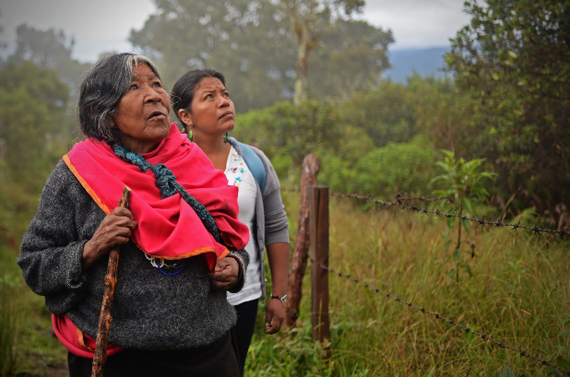
Mama Margarita (left) and Charito (right). Photo credit: Monika Wnuk
"These things have not been written down," Charito explains. "The information is passed on orally -- it's part of the Kamentsa's daily life and tradition. Our work documenting medicinal plants is moving along consistently. It is a colossal task, but one that needs to be done in order to preserve the knowledge left by the grandmothers."
Today the women will collect a tiny portion of Mama Margarita's knowledge -- a vast quantity of information she began accumulating before taking her first steps.
"When I was a baby, I went three days without drinking milk," Mama Margarita says. "My mom had a friend who was an herbalist. He saved me and made me drink milk again. He guided me, and no one explained the plants to me but him."
Mama Margarita's years of experience in the Andes become clear as the trail turns from well-worn grasses into a scene from an obstacle course. Clothing catches on tangled branches, people duck under logs, and deep mud pulls on rain boots like people suck barbeque sauce off their fingers. One misstep lands an unlucky hiker in a thigh-high mud puddle, filling her boot with mud. The sound of laughter and thesmack-smack-smack of steps becomes the soundtrack for the hike. After a few hours, most of us are filthy. Mama Margarita, however, remains remarkably tidy.
Once in a while, our group stops for a view of the valley and the Putumayo River whose blue-grey waters run over a riverbed of red and blue granite boulders and tumble down to join the greatest river of them all: the Amazon. With his extensive knowledge of the region, Narciso can point out the location of each future mine, as well as new construction initiated by the mining industry.
"They cut down trees and carved through mountains for a road," Narciso says, pointing across the valley. "They are using sand from the river for cement. The river water used to be drinkable, but now it is too dirty."
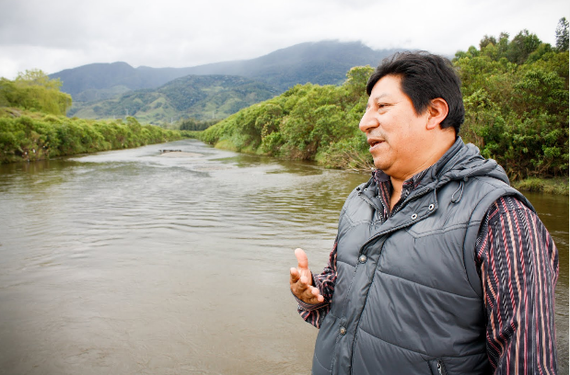
The day before the hike, José Narciso shows us a section of the Putumayo River where he swam as a child. Photo credit: Megan Taylor Morrison
According to Cuesta, mining can be the most destructive of development projects. Toxic contamination may occur as heavy metals are pulled from the ground and transported, and additional construction is often required for support.
"Huge infrastructure projects, such as dams for hydroelectric power, will have a profound effect on the capacity of the páramo system to recover," Cuesta explains.
These issues are not just environmental, but also legal, according to John I. Laun, a committed conservationist and lawyer who founded the Colombia Support Network -- an organization dedicated to improving human rights in the country -- in 1987.
In 2009, the Colombian Constitutional Court ordered the Colombian government to protect the Inga and Kamentsa communities, along with 32 other indigenous groups. However, development projects continue.
"The mining concessions violate the Colombian Constitution and laws because no prior consultation with the indigenous communities was carried out by the Colombian government," Laun said in a phone interview.
There are also plans to build a highway into the valley as part of The Initiative for the Integration of the Regional Infrastructure of South America (IIRSA), Laun adds. Launched in late 2000 through an agreement between 12 South American presidents, the project aims to better link the continent's economies. The new construction would provide mining trucks with a shorter trip between San Francisco in Sibundoy and Mocoa.
If the project is approved, the road will pass through sacred lands and disrupt ecosystems, including páramos. Each day, trucks laden with heavy metals will travel through this area, contaminating the watershed and disrupting local agriculture. The changes could have impacts far beyond the valley, Laun says.
"This is part of the Amazon rainforest region," he explains. "When you start fiddling around with what's happening and make changes in that area, you're actually threatening the water source and climate control source for a great part of humanity."
For Narciso, the development leads to a question of cultural survival.
"According to the technical studies presented by the Instituto Nacional de Vías (INVÍAS), approximately 15,000 hectares of natural forest will be destroyed, which in the elders' worldview means stripping and destroying our Mother Earth in order to construct 37 kilometers of highway," he wrote in a newsletter for CSN."The Kamentsa and the Inga of the Sibundoy Valley are worried about the existence of these two communities, just as they are worried about the existence of all indigenous communities in the Amazon region."
At the halfway point, we sip coffee sweetened with local cane sugar and snack onbocadillo, a thick paste made of guava fruit. The children are beginning to look tired, but Mama Margarita jokes with Charito as she sips from a bottle of water.

Mama Margarita (left) and Charito (right). Photo credit: Megan Taylor Morrison
Despite the loss of many elders and the great threats to the region, these women believe they are making critical headway to protect and document local culture.
"I am optimistic," Charito says. "I am very enthusiastic about making sure the seeds left behind by the grandmothers are planted so that the history can be available for future generations."
When Mama Margarita announces it's time to set off, the children groan. Their pace is now slower. In another two hours, the forest gives way suddenly to a mossy flat with incredible views of the surrounding Andes.
This is the páramo.
According to Cuesta, the sudden shift from dense forest to open grasslands is a hallmark of this ecosystem, and is due to two factors: soil temperature and UV radiation. As you move out from the tree line, these conditions change significantly, meaning different plants can thrive. The delicate balance suggests that changes due to climate or land use will drastically alter the ecosystem.
For now, however, the páramo looks unscathed. The tundra is covered with tall grasses and dense mosses that squish underfoot and allow the ecosystem to act like a giant sponge. By soaking up and releasing water gradually, páramos help maintain a steady water supply, Buytaert explains.
"They are the water towers for much of the Andes, including big cities such as Quito and Bogotá," he explains.
Mama Margarita walks over to one of the páramo's characteristic plants -- a frailejón(Espeletia) -- that could easily be mistaken for one of Dr. Seuss' truffula trees. The species has a round base like a pineapple and long, velvet-like leaves that extend from a thick trunk. Mama Margarita gives a leaf a firm tug and it breaks loose. When a person has a high fever, she says, a healer will boil the leaves in water and place them on the patient's thighs to reduce it. When the leaves are placed on the head, they can cure migraines, she adds.
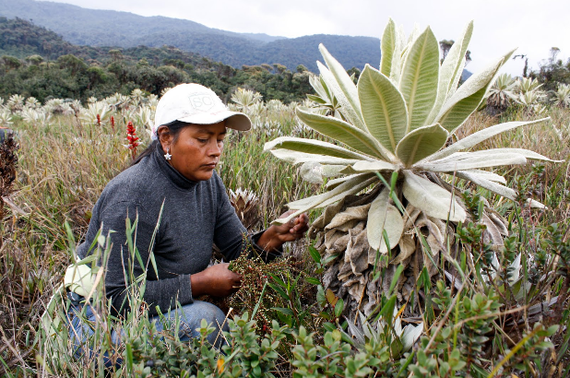
Rosa Clara Mutumbajoy, Mama Margarita's daughter and apprentice, gathers medicinal plants in the páramo. Photo credit: Megan Taylor Morrison
Mama Margarita then gets down on her hands and knees and begins to scavenge through the brush, holding up what appears to be a few straggly weeds. If you boil this plant, the broth can settle nausea, she says.
The day continues this way: Mama Margarita locates a plant, holds it up, and describes its use while everyone takes photos and careful notes. By the end of the day, she showcases an extensive collection. The plants' uses include lowering blood pressure, helping mothers produce milk for their babies, calming upset stomachs, curing stomach tumors and soothing arthritis.
"I thank my God that gives me the remedies," Mama Margarita says. "I hope the children won't miss the chance to learn."
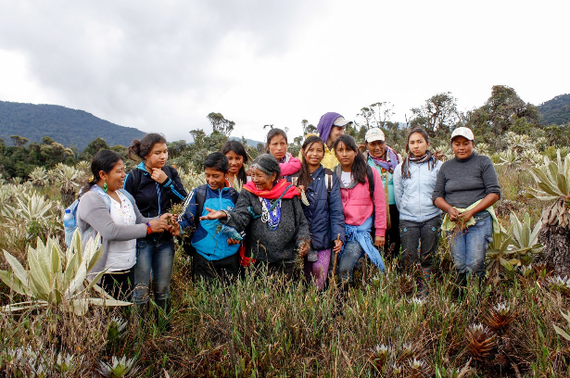
The hikers gather for a group photo. Photo credit: Megan Taylor Morrison
In the late afternoon, we slog back down the mountain with bags of herbs in tow. The bus picks us up a short time later and we head to the home of Luz Angelica, the daughter of another mama, for a traditional Colombian meal. Today was a special day and we celebrate over chicken soup, beef and salad.
"We came down with 14 different plants that the participants didn't know, and those plants can be planted at their homes, at the school or in the ASOMI garden," Ganitsky says. "It was an important moment to see how traditional knowledge is transmitted and strengthened."
As threats to the culture and land mount, the urgency of such initiatives is bringing the indigenous people of Sibundoy closer together, according to Charito.
"We collaborate on issues that endanger our autonomy and livelihood," she explains. "When there are threats, that's when we become stronger."
The trend is promising for conservation efforts, Cuesta says.
"In the past, it was more like Western society trying to help local people," he explains. "That model doesn't work anymore. The environmental agenda is being decentralized and many questions about how to manage land are given to local municipalities. [They] will have the last decision as to whether to turn the last hectares of páramo into a crop field or protect it for future generations."
Due to these developments, Narciso urges the international community to empower the traditional stewards of the land -- people like Mama Margarita, Charito and himself -- in order to produce the best results. He emphasizes this urgent need in his article:
"The elders ask the world to support them so that these two indigenous communities are not wiped out physically or culturally and, above all, so that future generations are able to live in a dignified way," he wrote. "If the land is not protected, the Kamentsa and Inga ancestral communities will soon be wiped out."
As the evening winds down, we offer to drop off Narciso at his home. During the drive, Charito notices the countless mosquito bites we acquired on the hike and offers to boil a tree bark she gathered that will soothe our skin.
In Narciso's kitchen, we drink sweet tea with cinnamon as we wait for the hot broth to cool. When it's ready, Charito dips her hands in the liquid and rubs our arms and legs in soothing strokes. A few minutes later, we gather our things and Narciso walks us to the door.
As we wave our final goodbyes, we can't help but notice a new sensation. We look at each other in silent confirmation. The itching is gone.
 RSS Feed
RSS Feed Twitter
Twitter 3:45 AM
3:45 AM
 Unknown
Unknown
